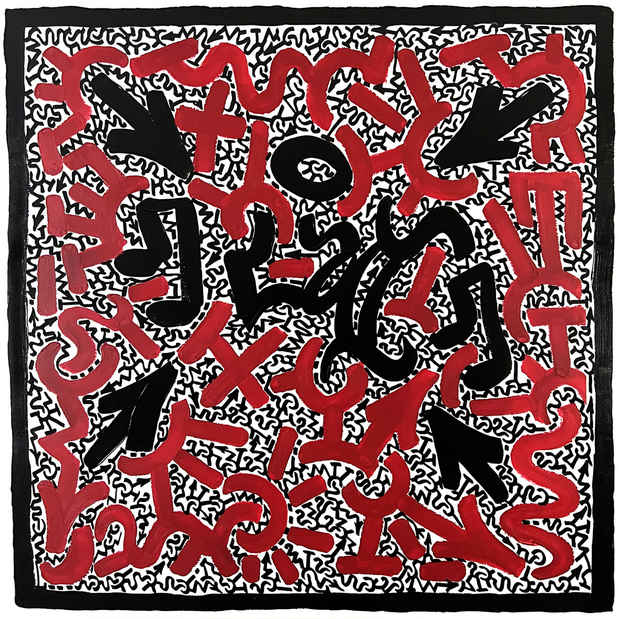“Walking the Line: Angel Ortiz (LA II)” Exhibition
Van Der Plas Gallery

This event has ended.
To whatever he puts his manic maestro hand to- in his most recent work we see cats, hearts, spray cans, flowers and moneybags added to his expansive repertoire of basic iconography- LA 2’s figuration is never so much the subject as the line itself. There is always the feeling with Angel Ortiz (more widely known as LA II) that representation is an excuse for abstraction- a boldly brutal and beautiful linear patterning that works at once as orgiastic ornamentation and rambling linguistics, a kind of language before, or beyond, the word.
Having followed the endless enrapturing line of LA II for some forty years now, by the very nature of his peripatetic journey and the twists and turns of his improvisational draftsmanship, one can never quite know where you’ll wind up in this pursuit, but will be enlivened nonetheless for the chase. Knowing Angel for nearly as long as I have known his art however, it seems to me that this line, cast out into the art world, proliferate on all manner of surface, and venturing all around the neighborhood in tags (which like most graffiti is an uninvited guest crashing the city’s commercial forest of signs), it would seem that this linear maze is his most direct and honest communication with the world. Angel Ortiz knows what he’s doing as an artist and can be quite articulate about it, but to really know where his heart and head are at you have to read the line itself. We may say this man walks the line, but in Angel’s case it might be more accurate to say he talks the line.
To consider LA 2’s paintings, which remain at the center of his studio practice, as compositional artifacts of a compulsive and conquering hand, we arrive at something of what the critic Clement Greenberg, in describing the work of Jackson Pollock, called the “all-over” picture or composition. Here, we get a sense of process taking over the centrality of composition, a disorientation or abnegation of the usual top or bottom, left or right, positioning of the picture plane as if subsumed by the effect. Certainly when Angel Ortiz includes figuration he does not suffer the indignity that some abstract painters do when their work is hung upside down, but in his patterning and accumulation of line, there always remains the sublime wonder of some other space- interstitial and approximate, deeply invested in the fabric of being, chaotic yet rational.
There is a condition called horror vacui, which is something like a dread or aversion to empty spaces. It comes from physics, as postulated by Aristotle that “nature abhors a vacuum,” but in the arts and design it connotes a fear of empty space that compels the creator to fill it up, much as Aristotle suggested nature does to all voids. This perhaps is the aesthetic raison d’être and psychologically fraught purpose of LA 2’s incessant line as it has run from his first tags as a teenager, through his most celebrated work in collaboration with Keith Haring, to the art he still produces today. When graffiti emerged at the economic nadir of New York City, disempowered and disenfranchised kids largely propagated it as a way to be seen and recognized in a society where they were largely invisible. By such a measure, Angel Ortiz has walked the line, he has made his mark, been recognized as few or his socio-economic background are, and as his line has become renown we have indeed been just as happy to know him.
Text by Carlo McCormick
– – –
LA II (a.k.a. Angel Ortiz, b. 1967) is a New York City graffiti artist best known for his collaborations with Keith Haring. Ortiz’s career took off after Haring spotted his “Little Angel” tag upon moving to New York and asked to meet the then-teenage artist. Throughout the ’80s, Haring and Ortiz combined their signatures to create murals, sculptures, train paintings, and other objects, and Ortiz’s style and technique are thought to have influenced Haring’s solo practice from then on. Along with several joint exhibitions of his work and Haring’s, Ortiz’s own mix of contemporary symbols with Asian calligraphy has been shown in galleries and museums across the United States.
Media
Schedule
from March 24, 2022 to April 24, 2022
Opening Reception on 2022-03-25 from 18:00 to 20:00